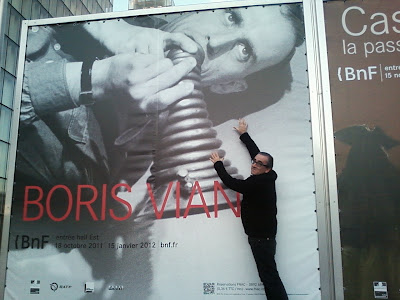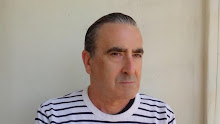Down below is a review by Boris Vian on an upcoming singer/songwriter Serge Gainsbourg. This is from Gilles Verlant's biography "Gainsbourg." Coming out on TamTam Books this Spring. The translation down below is by Paul Knobloch, who also translated into English Vian's "To Hell With The Ugly," "Autumn in Peking," and "The Dead All Have The Same Skin." All titles published by TamTam Books.
What we have here is one great artist appreciating another - and its really beautiful.
DU
CHANT A LA UNE: SERGE GAINSBOURG
Come
along, all you readers or listeners, those of you ready to rail
against all those phony songs and fake artists. Empty your pockets
and run to the record shops, and demand that the owner give you a
copy of the new Philips B 76447 B… This isn’t any payola: I
don’t work for Philips any longer, and even if I did I’d be
telling you the same thing.
It’s
the first 33 rpm from a witty individual named Gainsbourg, Serge,
born in Paris on April 2, 1928. As for me, I’m hoping it won’t
be his last. As for you, well, you’re the ones who can make sure
it’s not his last. An album is costly to make, and it’s also
costly to launch a new artist, especially when the owners of the
record shops, drowning in a sea of mediocre product and paralyzed by
rising sales tax, no longer have the time to listen to what the
record companies send them.
So
what will you hear on this disc?
First
of all – honoring those who are often forgotten – you’ll hear
Gainsbourg’s back-up players, thick as thieves and swinging
together under the direction of Alain Goraguer, who provides the
orchestration for the nine cuts on the album. Technically speaking,
each one easily ranks a 17 to 19 on a scale of 20, in spite of a
piano sometimes poorly tuned. But that’s not the fault of
Goraguer: in a recording session, a piano should be tuned to a
vibraphone.
You’ll
hear, tucked away in the middle of one side of the album, a song
sure to disturb you: “Ce mortel ennui qui me vient… quand je
suis près de toi…”5
You’ll
hear three absolute technical triumphs (phrasing, style, cadence,
etc.): “Le poinçonneur des Lilas,” somber, feverish, and
lovely, has also been done by Les Frères Jacques, who are quite
admirable. But listen to the real author do it. It’s the prototype
of powerful popular song that’s missing among artists like Yves
Montand. “Douze belles dans la peau” is also of superb quality.
Michèle Arnaud sings it rather well, I believe. Jean-Claude Pascal
also gives it a go: an homage to his good taste. “La femme des uns
sous le corps des autres,” with its South American rhythms, is
also both a bitter and exuberant success.
By
the way, if some numbskull wants to accuse Gainsbourg of pessimism,
I’ll permit myself to ask this same halfwit if he really loves
pleonasm that much, and if, by chance, he really listened to the
tune…
You’ll
hear “Ronasrd 58,” not as imaginative, but still a worthwhile
jazz number that’s not some dated piece like the ones we currently
hear in France that try to evoke the spirit of jazz from 1935 (which
would be just fine if it were 1935).
You’ll
hear “La recette de l’amour fou” and you’ll remember, since
I’m going to tell you, that Gainsbourg regrets but one thing,
which is not having been able to know the director of the Ecole
universelle of surrealism, André Breton.
You’ll
also find “L’alcool,” “Du jazz dans le ravin,” and “Le
Charleston des déménageurs de piano.” This last tune is a great
illustration of just what the piano can do, and it’s simply
delicious for those who play or those who simply like to listen.
Still, from time to time, we should consider those who actually do
the work of moving…
And
after having heard all that, the phonies among you will tell me that
Gainsbourg has a weak singing voice. And while it might be a bit
muted or too nasal, remember that he’s not singing opera. You want
opera? Go buy some Xavier Depraz. Gainsbourg might remind you, now
and then, of Phillipe Clay. Yes, because their voices have a similar
timbre. And so what? Gainsbourg also has that tense and biting
quality you find with Clay.
You’ll
also probably tell me that this young lad is a bit skeptical, that
it is wrong to see everything in such dark terms, that there’s
nothing “constructive” in his work… (sure… fine… if that’s
what you say).
To
which I would respond that a skeptic who writes words and music like
this, well, you had better give him a second listen before just
grouping him in with the other blasé artists of the nouvelle vague…
It’s still much more interesting than some idiotic enthusiast
eager to attack whatever displeases him…
And
after all, this is 1958. We’re capable of coming up with something
better than images of baroque pavilions with bluish-green cats
staring down at us from the rooftops.
Still,
there’s something missing on this album. One song, perhaps
Gainsbourg’s best: a little love ditty about a cannonball and a
wooden peg-leg searching for a home.
It’s
a piece called “Friedland.”
Gainsbourg’s
already recorded it.
But
alas, it’s not part of this album. You’ll have to go to Milord
l’Arsouille to hear Gainsbourg sing it.
They
must have taken it off the disc in order not to displease the good
king Charles XI.
Nevertheless,
if I am not mistaken, might not Freidland become the Usurper?
Boris Vian

















































